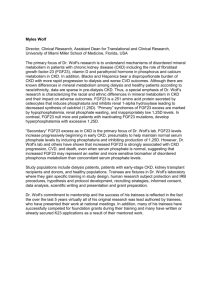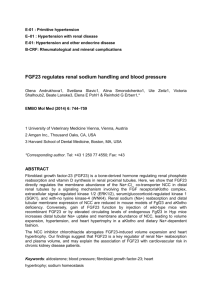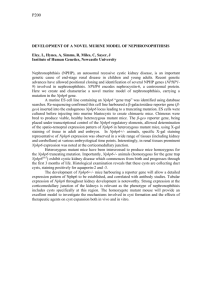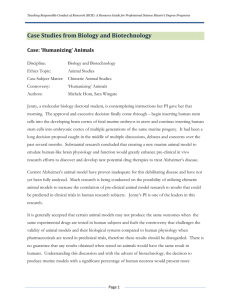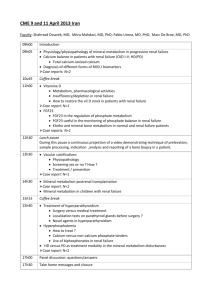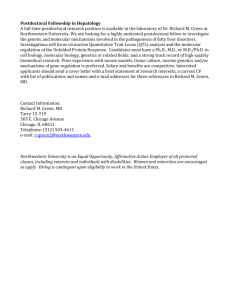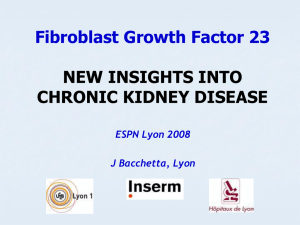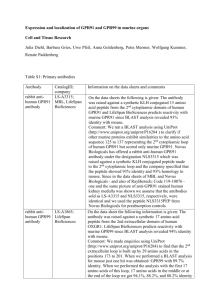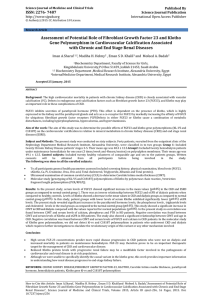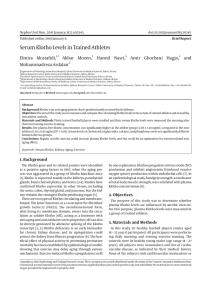Supplementary Methods - Word file (56 KB )
advertisement
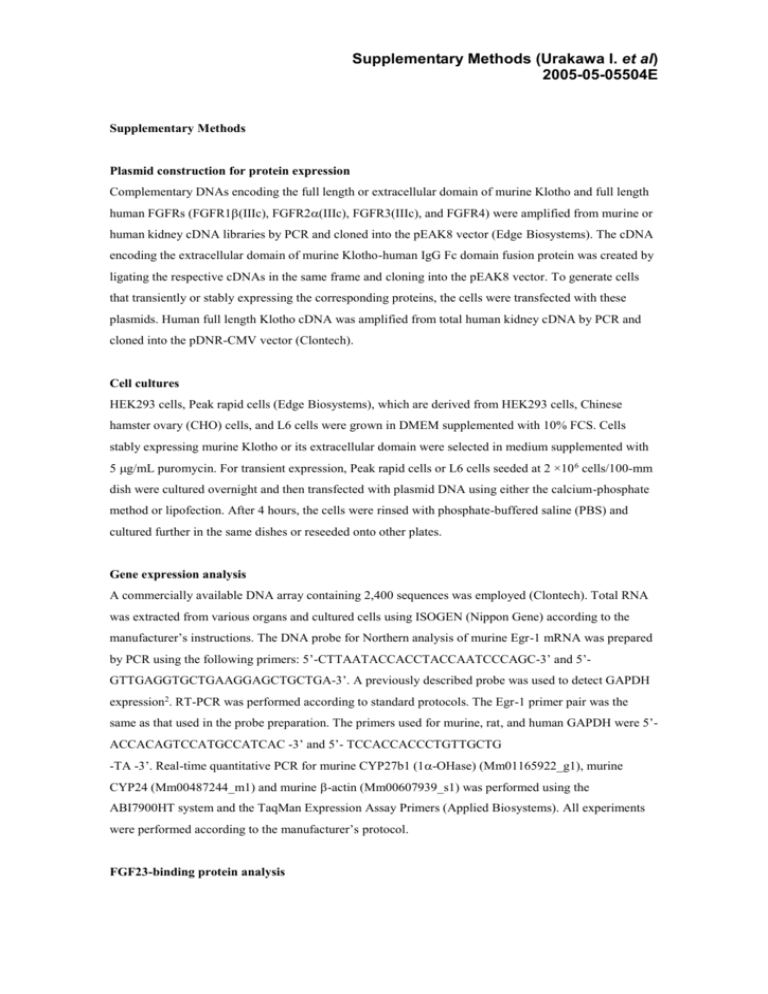
Supplementary Methods (Urakawa I. et al) 2005-05-05504E Supplementary Methods Plasmid construction for protein expression Complementary DNAs encoding the full length or extracellular domain of murine Klotho and full length human FGFRs (FGFR1(IIIc), FGFR2(IIIc), FGFR3(IIIc), and FGFR4) were amplified from murine or human kidney cDNA libraries by PCR and cloned into the pEAK8 vector (Edge Biosystems). The cDNA encoding the extracellular domain of murine Klotho-human IgG Fc domain fusion protein was created by ligating the respective cDNAs in the same frame and cloning into the pEAK8 vector. To generate cells that transiently or stably expressing the corresponding proteins, the cells were transfected with these plasmids. Human full length Klotho cDNA was amplified from total human kidney cDNA by PCR and cloned into the pDNR-CMV vector (Clontech). Cell cultures HEK293 cells, Peak rapid cells (Edge Biosystems), which are derived from HEK293 cells, Chinese hamster ovary (CHO) cells, and L6 cells were grown in DMEM supplemented with 10% FCS. Cells stably expressing murine Klotho or its extracellular domain were selected in medium supplemented with 5 g/mL puromycin. For transient expression, Peak rapid cells or L6 cells seeded at 2 ×10 6 cells/100-mm dish were cultured overnight and then transfected with plasmid DNA using either the calcium-phosphate method or lipofection. After 4 hours, the cells were rinsed with phosphate-buffered saline (PBS) and cultured further in the same dishes or reseeded onto other plates. Gene expression analysis A commercially available DNA array containing 2,400 sequences was employed (Clontech). Total RNA was extracted from various organs and cultured cells using ISOGEN (Nippon Gene) according to the manufacturer’s instructions. The DNA probe for Northern analysis of murine Egr-1 mRNA was prepared by PCR using the following primers: 5’-CTTAATACCACCTACCAATCCCAGC-3’ and 5’GTTGAGGTGCTGAAGGAGCTGCTGA-3’. A previously described probe was used to detect GAPDH expression2. RT-PCR was performed according to standard protocols. The Egr-1 primer pair was the same as that used in the probe preparation. The primers used for murine, rat, and human GAPDH were 5’ACCACAGTCCATGCCATCAC -3’ and 5’- TCCACCACCCTGTTGCTG -TA -3’. Real-time quantitative PCR for murine CYP27b1 (1-OHase) (Mm01165922_g1), murine CYP24 (Mm00487244_m1) and murine -actin (Mm00607939_s1) was performed using the ABI7900HT system and the TaqMan Expression Assay Primers (Applied Biosystems). All experiments were performed according to the manufacturer’s protocol. FGF23-binding protein analysis Supplementary Methods (Urakawa I. et al) 2005-05-05504E Purified mutant FGF23 (R176Q, R179Q) protein30 was conjugated to NHS-activated Sepharose (Amersham). A murine kidney homogenate was prepared in PBS containing a protease inhibitor cocktail (Roche) and the 8,000×g-unprecipitable and 100,000×g-precipitable fractions were resuspended in PBS containing 1% Triton X-100 and protease inhibitor cocktail and incubated with FGF23-Sepharose. The specifically retained proteins on the resin were solubilized by boiling in SDS-PAGE sample buffer and separated by SDS-PAGE. The protein bands visualized by silver staining were analyzed by MALDI-TOF mass spectrometry. Radiolabeled ligand binding assay Purified recombinant FGF23 (R176Q, R179Q) was iodinated with Na 125I (Perkin Elmer) using IODOGEN Pre-coated Iodination Tubes (Pierce) according to the manufacturer’s instruction. The specific activity of the obtained 125I-FGF23 was 30,000-60,000 cpm/ng. The binding assay using 125I-FGF23 was performed as previously described31. Cells cultured in 24-well plates were placed on ice and incubated with the binding buffer containing various concentrations of 125I-FGF23 for 3 h. Excessive cold FGF23 (over 500-fold) or heparin was added at the beginning of the incubation. The cell layers were washed with PBS containing BSA (2.5 mg/mL) 4 times and subjected to the measurement of radioactivity. Flow cytometric analysis Klotho-expressing cells were suspended in suspension buffer (PBS/azide/2% FBS) and incubated with FGF23 (1 g/mL) on ice for 30 min. After washing twice with the suspension buffer, the cells were incubated with the polyclonal anti-FGF23 antibody for 30 min. The cells were then washed twice and incubated with anti-rabbit IgG antibody conjugated with Phycoerythrin (Southern Bioscience). The cells were analyzed on a FACScan instrument (BD Biosciences) using CellQuest software. EGR-1-reporter assay The murine Egr-1 promoter region (-1023 - +1)17 was amplified from murine genomic DNA by PCR and inserted into the pGL3 basic vector (Promega) to generate the Egr-1-luciferase reporter vector. Cells transfected with the Egr-1-luciferase reporter and various plasmids were seeded in 96-well plates and cultured overnight. On the following day, the cells were stimulated with recombinant FGF23 or bFGF in the presence or absence of 10 g/mL heparin (Seikagaku) or other glycosaminoglycans (Seikagaku; see Supplementary Figure 1). Anti-Klotho antibodies or FGFR-Fc fusion proteins were also added at this point. After a 24-hour incubation, the luciferase activity in each well was measured using SteadyGlo (Promega), according to the manufacturer’s instructions. Immunoprecipitation and immunoblotting analysis Supplementary Methods (Urakawa I. et al) 2005-05-05504E Immunoprecipitation of FGFR1 and tyrosine-phosphorylated proteins from cell lysates was performed using anti-FGFR1 antibody conjugated beads (SantaCruz) and anti-phosphotyrosine antibody (PY20) conjugated beads (SantaCruz), respectively. Egr-1, Phospho-ERK1/2, and ERK1/2 were detected by immunoblotting using anti-Egr-1, anti-phospho-ERK, and anti-ERK antibodies (SantaCruz), as previously described12. FGFR1, phosphorylated-FGFR, FRS2, and phosphorylated-FRS2, were detected using anti-FGFR1 (SantaCruz) or anti-phospho-FGFR1 (R&D Systems), anti-FRS2 (SantaCruz), and anti-phospho-FRS2 (Cell Signaling). Immunoblotting of the renal sodium phosphate cotransporter type IIa (NaPi2a) was performed as previously described6. Murine Klotho, human FGF23, and the FGFR-Fc fusion protein were detected using the polyclonal anti-murine Klotho antibody, anti FGF23 monoclonal antibody4, and the anti-human IgG (Fc)-HRP antibody (IBL), respectively. Antibody generation The recombinant extracellular domain of murine Klotho was purified from conditioned medium of CHO cells that stably express this protein by a series of chromatographic steps employing Q-Sepharose FF, ConA-Sepharose 4B, Wheat Germ Lectin-Sepharose, DEAE-Sepharose FF, and Q Sepharose HP. All columns were purchased from Amersham. Rats were immunized with the purified protein and their spleen cells were subjected to hybridoma generation. Hybridoma selection was on the basis of the ability to bind to native Klotho protein, as determined by flow cytometric analysis. The 70E2 monoclonal antibody was purified from conditioned medium of hybridoma cultures by Protein G-Sepharose chromatography. Polyclonal anti-human FGF23 and anti-murine Klotho antibodies were generated by immunizing rabbits with purified human recombinant FGF2330 or a synthesized peptide corresponding to a sequence in the murine Klotho protein (aa 118-138), respectively. Animal experiments All animal experiments were performed using protocols approved by the Institutional Animal Care and Use Committee of the Pharmaceutical Research Laboratories, Kirin Brewery Co., Ltd. Klotho-deficient (kl/kl) mice and Klotho-insufficient (kl/+) mice were purchased from JAPAN CLEA. Fgf23(+/-) and Fgf23(-/-) mice were maintained as described previously17. Balb/c mice and Sprague Dawley rats were purchased from JAPAN SLC. To prepare total RNA from various organs and renal homogenates, recombinant FGF23 (150 g/kg) or vehicle was intravenously injected into 7-week-old mice (n = 2 each) or 8-week-old rats (n = 2 each) and, after anesthesia, the animals were sacrificed and organs collected. The anti-murine Klotho monoclonal antibody (70E2, 100 g/animal) was intravenously administered to 8-week-old male Balb/c mice (n = 5). Blood samples were taken under anesthesia with diethyl ether. Serum 1,25(OH)2 vitamin D, phosphate, calcium, PTH, and FGF23 concentrations were measured as described previously6. Kidneys were collected from animals sacrificed under anesthesia and brush border membranes were prepared as described previously6. Supplementary Methods (Urakawa I. et al) 2005-05-05504E Fgf23(+/-), kl/-, and Fgf23(+/-)(kl+/-) mice To obtain double heterozygous of Fgf23+/- and kl/+ mice, the heterozygous of klotho-deficient mice were crossed with heterozygous of Fgf23 knockout mice. Genotyping of klotho was performed by a combination of genomic PCRs with the following primers: GKU-01 (5’-TTGTGGAGATTGGAAG -TGGACGAAAGAG-3’) and GKL-01(5’-CGCCCCGACCGGAGCTGAGAGTA-3’) for mutant allele, and GKU-01 (5’-TTGTGGAGATTGGAAGTGGACGAAAGAG-3’) and GKL-02 (5’-CTGG -ACCCCCTGAAGCTGGAGTTAC-3’) for wild type allele. Genotyping of FGF23 was performed as previously described18. Pull-down assay To analyze proteins forming complexs with FGFR1(IIIc), 0.5 g of an FGFR1(IIIc)-Fc fusion protein (R&D Systems) was mixed with conditioned medium containing the recombinant extracellular domain of murine Klotho, 10 g/mL heparin, and either FGF23 or bFGF (0.5 g). To analyze the interaction between Klotho and FGF23, 0.1 g of FGF23 was mixed with conditioned medium containing the recombinant extracellular domain of murine Klotho-Fc fusion protein. Protein G-sepharose was added and the samples were incubated on ice. The resins were washed thoroughly and bound proteins were solubilized by boiling with SDS PAGE sample buffer and analyzed by Western blotting for FGFR-Fc, Klotho, and FGF23 or bFGF. References in Supplementary Methods 31 Dionne, C. A. et al. Cloning and expression of two distinct high-affinity receptors cross-reacting with acidic and basic fibroblast growth factors. EMBO J 9, 2685-92 (1990).
